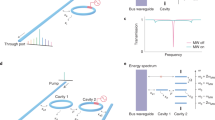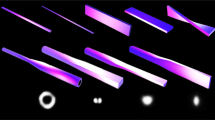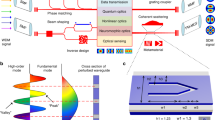Abstract
Efficient frequency shifting and beam splitting are important for a wide range of applications, including atomic physics1,2, microwave photonics3,4,5,6, optical communication7,8 and photonic quantum computing9,10,11,12,13,14. However, realizing gigahertz-scale frequency shifts with high efficiency, low loss and tunability—in particular using a miniature and scalable device—is challenging because it requires efficient and controllable nonlinear processes. Existing approaches based on acousto-optics6,15,16,17, all-optical wave mixing10,13,18,19,20,21,22 and electro-optics23,24,25,26,27 are either limited to low efficiencies or frequencies, or are bulky. Furthermore, most approaches are not bi-directional, which renders them unsuitable for frequency beam splitters. Here we demonstrate electro-optic frequency shifters that are controlled using only continuous and single-tone microwaves. This is accomplished by engineering the density of states of, and coupling between, optical modes in ultralow-loss waveguides and resonators in lithium niobate nanophotonics28. Our devices, consisting of two coupled ring-resonators, provide frequency shifts as high as 28 gigahertz with an on-chip conversion efficiency of approximately 90 per cent. Importantly, the devices can be reconfigured as tunable frequency-domain beam splitters. We also demonstrate a non-blocking and efficient swap of information between two frequency channels with one of the devices. Finally, we propose and demonstrate a scheme for cascaded frequency shifting that allows shifts of 119.2 gigahertz using a 29.8 gigahertz continuous and single-tone microwave signal. Our devices could become building blocks for future high-speed and large-scale classical information processors7,29 as well as emerging frequency-domain photonic quantum computers9,11,14.
This is a preview of subscription content, access via your institution
Access options
Access Nature and 54 other Nature Portfolio journals
Get Nature+, our best-value online-access subscription
$29.99 / 30 days
cancel any time
Subscribe to this journal
Receive 51 print issues and online access
$199.00 per year
only $3.90 per issue
Buy this article
- Purchase on Springer Link
- Instant access to full article PDF
Prices may be subject to local taxes which are calculated during checkout




Similar content being viewed by others
Data availability
The datasets generated and analysed during the current study are available from the corresponding author on reasonable request.
References
Greiner, M., Mandel, O., Esslinger, T., Hänsch, T. W. & Bloch, I. Quantum phase transition from a superfluid to a Mott insulator in a gas of ultracold atoms. Nature 415, 39–44 (2002).
Hu, J. et al. Creation of a Bose-condensed gas of 87Rb by laser cooling. Science. 358, 1078–1080 (2017).
Supradeepa, V. R. et al. Comb-based radiofrequency photonic filters with rapid tunability and high selectivity. Nat. Photon. 6, 186–194 (2012).
Marpaung, D., Yao, J. & Capmany, J. Integrated microwave photonics. Nat. Photon. 13, 80–90 (2019).
Fandiño, J. S., Muñoz, P., Doménech, D. & Capmany, J. A monolithic integrated photonic microwave filter. Nat. Photon. 11, 124–129 (2016).
Eggleton, B. J., Poulton, C. G., Rakich, P. T., Steel, M. J. & Bahl, G. Brillouin integrated photonics. Nat. Photon. 13, 664–677 (2019).
Yoo, S. J. B. Wavelength conversion technologies for WDM network applications. J. Light. Technol. 14, 955–966 (1996).
Lukens, J. M. et al. All-optical frequency processor for networking applications. J. Light. Technol. 38, 1678–1687 (2020).
Kues, M. et al. On-chip generation of high-dimensional entangled quantum states and their coherent control. Nature 546, 622–626 (2017).
Kobayashi, T. et al. Frequency-domain Hong–Ou–Mandel interference. Nat. Photon. 10, 441–444 (2016).
Lukens, J. M. & Lougovski, P. Frequency-encoded photonic qubits for scalable quantum information processing. Optica 4, 8–16 (2016).
Lu, H. H. et al. Electro-optic frequency beam splitters and tritters for high-fidelity photonic quantum information processing. Phys. Rev. Lett. 120, 30502 (2018).
Joshi, C. et al. Frequency-domain quantum interference with correlated photons from an integrated microresonator. Phys. Rev. Lett. 124, 143601 (2020).
Kues, M. et al. Quantum optical microcombs. Nat. Photon. 13, 170–179 (2019).
Kittlaus, E. A., Otterstrom, N. T., Kharel, P., Gertler, S. & Rakich, P. T. Non-reciprocal interband Brillouin modulation. Nat. Photon. 12, 613–619 (2018).
Sohn, D. B., Kim, S. & Bahl, G. Time-reversal symmetry breaking with acoustic pumping of nanophotonic circuits. Nat. Photon. 12, 91–97 (2018).
Liu, Q., Li, H. & Li, M. Electromechanical Brillouin scattering in integrated optomechanical waveguides. Optica 6, 778–785 (2019).
Huang, J. & Kumar, P. Observation of quantum frequency conversion. Phys. Rev. Lett. 68, 2153–2156 (1992).
Li, Q., Davanço, M. & Srinivasan, K. Efficient and low-noise single-photon-level frequency conversion interfaces using silicon nanophotonics. Nat. Photon. 10, 406–414 (2016).
Heuck, M. et al. Unidirectional frequency conversion in microring resonators for on-chip frequency-multiplexed single-photon sources. New J. Phys. 21, 33037 (2019).
Raymer, M. G., van Enk, S. J., McKinstrie, C. J. & McGuinness, H. J. Interference of two photons of different colour. Opt. Commun. 283, 747–752 (2010).
Pelc, J. S. et al. Dual-channel, single-photon upconversion detector at 13 μm. Opt. Express 20, 19075–19087 (2012).
Preble, S. F., Xu, Q. & Lipson, M. Changing the colour of light in a silicon resonator. Nat. Photon. 1, 293–296 (2007).
Johnson, L. M. & Cox, C. H. Serrodyne optical frequency translation with high sideband suppression. J. Light. Technol. 6, 109–112 (1988).
Izutsu, M., Shikama, S. & Sueta, T. Integrated optical SSB modulator/frequency shifter. IEEE J. Quantum Electron. 17, 2225–2227 (1981).
Wright, L. J., Karpiński, M., Söller, C. & Smith, B. J. Spectral shearing of quantum light pulses by electro-optic phase modulation. Phys. Rev. Lett. 118, 23601 (2017).
Savchenkov, A. A. et al. Tunable optical single-sideband modulator with complete sideband suppression. Opt. Lett. 34, 1300–1302 (2009).
Zhang, M., Wang, C., Cheng, R., Shams-Ansari, A. & Lončar, M. Monolithic ultra-high-Q lithium niobate microring resonator. Optica 4, 1536–1537 (2017).
Frankel, M. Y. & Esman, R. D. Optical single-sideband suppressed-carrier modulator for wide-band signal processing. J. Light. Technol. 16, 859–863 (1998).
Lo, H.-P. & Takesue, H. Precise tuning of single-photon frequency using an optical single sideband modulator. Optica 4, 919–923 (2017).
Xu, M. et al. High-performance coherent optical modulators based on thin-film lithium niobate platform. Nat. Commun. 11, 3911 (2020).
Fan, L. et al. Integrated optomechanical single-photon frequency shifter. Nat. Photon. 10, 766–770 (2016).
Zhang, M. et al. Electronically programmable photonic molecule. Nat. Photon. 13, 36–40 (2019).
He, L. et al. Low-loss fibre-to-chip interface for lithium niobate photonic integrated circuits. Opt. Lett. 44, 2314–2317 (2019).
Khan, S. et al. Low-loss, high-bandwidth fibre-to-chip coupling using capped adiabatic tapered fibers. APL Photonics 5, 056101 (2020).
Yuan, L., Lin, Q., Xiao, M. & Fan, S. Synthetic dimension in photonics. Optica 5, 1396–1405 (2018).
Hu, Y., Reimer, C., Shams-Ansari, A., Zhang, M. & Loncar, M. Realization of high-dimensional frequency crystals in electro-optic microcombs. Optica 7, 1189–1194 (2020).
Wang, C. et al. Integrated lithium niobate electro-optic modulators operating at CMOS-compatible voltages. Nature 562, 101–104 (2018).
Soltani, M. et al. Efficient quantum microwave-to-optical conversion using electro-optic nanophotonic coupled resonators. Phys. Rev. A 96, 043808 (2017).
Sinclair, N. et al. Spectral multiplexing for scalable quantum photonics using an atomic frequency comb quantum memory and feed-forward control. Phys. Rev. Lett. 113, 053603 (2014).
Joshi, C., Farsi, A., Clemmen, S., Ramelow, S. & Gaeta, A. L. Frequency multiplexing for quasi-deterministic heralded single-photon sources. Nat. Commun. 9, 847 (2018).
Grimau Puigibert, M. et al. Heralded single photons based on spectral multiplexing and feed-forward control. Phys. Rev. Lett. 119, 083601 (2017).
Ghelfi, P. et al. A fully photonics-based coherent radar system. Nature 507, 341–345 (2014).
Demtröder, W. Laser Spectroscopy. Volume 2: Experimental Techniques (Springer, 2008).
Kohlhaas, R. et al. Robust laser frequency stabilization by serrodyne modulation. Opt. Lett. 37, 1005–1007 (2012).
Wang, C. et al. Monolithic lithium niobate photonic circuits for Kerr frequency comb generation and modulation. Nat. Commun. 10, 978 (2019).
Acknowledgements
We thank C. Wang, C. Reimer, J. Lukens and P. Lougovski for helpful discussions. This work is supported by the US Office of Naval Research (QOMAND N00014-15-1-2761), Air Force Office of Scientific Research (FA9550‐19‐1‐0310 and FA9550-20-1-0105), National Science Foundation (ECCS-1839197, ECCS-1541959 and PFI-TT IIP-1827720), Army Research Office (W911NF2010248), and Department of Energy (HEADS-QON DE-SC0020376). Device fabrication was performed at the Harvard University Center for Nanoscale Systems. D.Z. acknowledges support by the Harvard Quantum Initiative post-doctoral fellowship. N.S. acknowledges support by the Natural Sciences and Engineering Research Council of Canada (NSERC) and the AQT Intelligent Quantum Networks and Technologies (INQNET) research programme. E.P. acknowledges support by a Draper Fellowship.
Author information
Authors and Affiliations
Contributions
Y.H. and M.Z. conceived the idea. Y.H. developed the theory, performed numerical simulations and fabricated the devices. Y.H., M.Y. and D.Z. carried out the measurements with N.S. assisting. Y.H., N.S., D.Z., M.Y., M.Z. and M.L. wrote the manuscript. A.S.-A., L.S., J.H. and E.P. helped with the project. M.L. supervised the project.
Corresponding author
Ethics declarations
Competing interests
M.Z. and M.L. are involved in developing lithium niobate technologies at HyperLight Corporation.
Additional information
Peer review information Nature thanks Andrew Weiner and the other, anonymous, reviewer(s) for their contribution to the peer review of this work. Peer reviewer reports are available.
Publisher’s note Springer Nature remains neutral with regard to jurisdictional claims in published maps and institutional affiliations.
Extended data figures and tables
Extended Data Fig. 1 Illustration of the cross-section of one of the two-resonator devices, set-up of frequency shift measurements, and optical transmission spectra.
a, Cross-section of one of the two-resonator devices. The parameters labelled in the cross-section are \(w=1.2\,{\rm{\mu }}{\rm{m}}\), \(h=350\,{\rm{nm}}\), \(t=250\,{\rm{nm}}\), \({d}_{1}=300\,{\rm{nm}}\), \({d}_{2}=500\,{\rm{nm}}\), and \({h}_{1}={h}_{2}=800\,{\rm{nm}}\). b, Set-up for measuring frequency up- and down-shifts. PC, polarization controller; OSA, optical spectrum analyser; PD, photodetector. c, Measured transmission spectrum of the 12.5-GHz two-resonator device (Fig. 2b, c) when the microwave drive is turned off (left panel) and on (right panel). d, Simulation of the transmission and phase spectra of the 12.5-GHz two-resonator device in the presence and absence of the microwave drive. MW, microwave.
Extended Data Fig. 2 Polarization of the frequency shifter output.
This measurement is performed on a two-resonator device with \(11.0\,{\rm{GHz}}\) doublet splitting. The TE and TM components of the output light are measured using an optical spectrum analyser after passing a polarizer. Here the power is normalized by the summation of TE and TM output powers.
Extended Data Fig. 3 Modulation bandwidth and frequency channel shifting with pseudorandom bit sequences.
a, Experimental set-ups. The input laser beam is modulated by either a sinusoidal signal from the port 1 of a vector network analyser (VNA) (bandwidth measurement) or an actual data stream that is generated by an arbitrary waveform generator (AWG) (eye diagram measurement). The input light is up-shifted and detected by a photodetector (PD) followed by either port 2 of the VNA (bandwidth measurement) or an oscilloscope (eye diagram measurement). The measurements are performed at a wavelength of 1,560 nm on the two-resonator device in Fig. 2b, c, in which the doublet splitting is 11.3 GHz due to optical dispersion (doublet splitting is 12.5 GHz at 1,601 nm). b, Measured modulation bandwidth of the device. The 3-dB modulation bandwidth is 2.2 GHz, corresponding to an optical bandwidth of 4.4 GHz. The modulation bandwidth is broadened to 4.1 GHz by increasing the microwave driving power from 126 mW to 398 mW. c, Measured eye diagrams when using actual data streams to modulate the input laser beam. The eye diagrams before shift are measured by setting the input laser beam off-resonance with the filter window centered to the input wavelength (filter bandwidth unchanged). By comparing the amplitude of the eye diagrams before and after swap, we found the loss is ~1 dB which is consistent with the on-chip loss (0.92 dB).
Extended Data Fig. 4 Simulated shift ratio as a function of the detuning of the laser.
The simulated two-resonator device is optimized for high optical bandwidth. Design parameters: \(\gamma \,=\,2{\rm{\pi }}\times 20\,{\rm{GHz}}\) (leads to a \({\kappa }_{{\rm{e}}}\,=\,2{\rm{\pi }}\times 10\,{\rm{GHz}}\)), \({\kappa }_{{\rm{int}}}\,=\,2{\rm{\pi }}\times 170\,{\rm{MHz}}\), \({\omega }_{{\rm{m}}}=2{\rm{\pi }}\times 28.2\,{\rm{GHz}}\). A 3-dB optical bandwidth of \( \sim 14\,{\rm{GHz}}\) can be achieved using a critical-drive microwave power of \(1.35\,{\rm{W}}\) with a \(26.7\,{\rm{dB}}\) suppression of parasitic sidebands and \(0.13\,{\rm{dB}}\) on-chip loss. The microwave power for a 50–50 split on such a device is expected to be \(238\,{\rm{mW}}\).
Extended Data Fig. 5 Crosstalk measurement for channel swapping.
a, Experimental set-ups for the crosstalk measurement. Two input laser beams are each independently modulated by a sinusoidal signal to define two distinct frequency channels, sent into a two-resonator device, and detected by an OSA and a PD followed by an RSA. The sinusoidal signal applied to the input beam of channel 1 (matching the S resonance) is swept from \(200\,{\rm{MHz}}\) to \(2.8\,{\rm{GHz}}\) while the sinusoidal signal on the input beam of channel 2 (matching the AS resonance) is kept at 1 GHz. Each channel is selected by a tunable filter. b, Radio-frequency spectrum for channel 1 and channel 2 after the swap when the modulation frequency in channel 1 is set to \(2.6\,{\rm{GHz}}\) depicts low crosstalk in the swap measurements. The crosstalk is defined as the ratio between the shifted frequency and the residual frequency. The frequency component of \(1.6\,{\rm{GHz}}\) that appears in channel 1 is the beat note between the shifted frequency and the residual frequency. The \(2\,{\rm{GHz}}\) component is the second harmonic signal that is generated by the amplitude modulator, which is verified beforehand. c, Measured crosstalk for two channels when sweeping the modulation frequency in channel 1 from \(200\,{\rm{MHz}}\) to \(2.8\,{\rm{GHz}}\). We find the crosstalk to be approximately \(-35\,{\rm{dB}}\) at low frequency (several hundreds of MHz) and approximately \(-25\,{\rm{dB}}\) at \(2.8\,{\rm{GHz}}\). PC, polarization controller; AM, amplitude modulator, EDFA, erbium-doped fibre amplifier; OSA, optical spectrum analyser; PD, photodetector; RSA, real-time spectrum analyser.
Extended Data Fig. 6 Varying the shift frequency with d.c. voltage.
Each of the resonators in a 12.5-GHz two-resonator device (Fig. 2b, c) are detuned from each other using a d.c. voltage to provide a variation of the frequency difference between the two hybrid modes. For each frequency difference between two modes, the microwave frequency is changed to match this difference, while the powers of the microwave signals are kept constant and equal to that used when the resonances of each ring are degenerate (Fig. 2b, c). The shift ratio remains >0.9 when the shift frequency is detuned \( > 20\,{\rm{GHz}}\).
Extended Data Fig. 7 Limitation of the on-chip loss and parasitic sidebands.
a, Predicted two-resonator on-chip loss with varied \({Q}_{{\rm{intrinsic}}}\) for different waveguide–ring couplings γ. The theoretical curve of on-chip loss is calculated under the optimal condition of both pump and microwave detunings are zero. The measured on-chip loss of the \(11.0\,{\rm{GHz}}\), \(12.5\,{\rm{GHz}}\) and \(28.2\,{\rm{GHz}}\) devices used in this work are labelled with a triangle, square, and diamond, respectively. b, Simulation of the normalized power of the parasitic sidebands as a function of the shift frequency. The waveguide–cavity coupling rate \(\gamma \) is varied from \(2{\rm{\pi }}\times 1\,{\rm{GHz}}\) to \(2{\rm{\pi }}\times 7\,{\rm{GHz}}\). Waveguide–cavity coupling rates that are as high as \(2{\rm{\pi }}\times 7\,{\rm{GHz}}\) can still keep the parasitic sidebands suppressed below \(20\,{\rm{dB}}\) for shift frequencies \( > 10\,{\rm{GHz}}\) and below \(30\,{\rm{dB}}\) for shifts that are \( > 30\,{\rm{GHz}}\). In this work, the parasitic sidebands are lower than \(25\,{\rm{dB}}\) in devices at shift frequencies of \(10\,-\,30\,{\rm{GHz}}\).
Extended Data Fig. 8 Simulated electrode performance for varied microwave frequencies.
a, The relative voltage delivered to the capacitor VC and probe \({V}_{0}\) for varied microwave frequencies. b, Power required at the probe (\(50\,\Omega \)) for a maximal shift ratio as a function of microwave frequency. Our current \(28.2\,{\rm{GHz}}\) two-resonator device requires \(188\,{\rm{mW}}\) of theoretical microwave power (\(4.34\,{\rm{V}}\) microwave peak voltage). We assume that the voltage VC delivered to the capacitor is kept identical to the peak-voltage on capacitor (VC = 7.46 V) of our \(28.2\,{\rm{GHz}}\) device when reaching \(0.987\) shift ratio. MW, microwave.
Extended Data Fig. 9 Simulation of the cascaded frequency shifter.
a, Simulated optical spectrum shows a cascaded frequency shift when the GCC condition is satisfied. A single microwave tone at \(30\,{\rm{GHz}}\) (equal to the FSR of ring 2) generates a five-mode cascaded frequency shift of \(120\,{\rm{GHz}}\) with an on-chip loss of \(1.1\,{\rm{dB}}\). The inset illustrates the energy flow in the coupled cavities system. The frequency of mode 1 in the x axis of the inset is denoted by \({\omega }_{1}\). b, The shift can be scaled to a larger number of modes, with an incremental on-chip loss of \(0.15\,{\rm{dB}}\) per mode.
Supplementary information
Supplementary Audio File
Two different and repeated sounds are chosen to be the left channel and the right channel of the audio file. In the experiment, the left channel and the right channel of the audio file are used to drive the two different amplitude modulators for laser beam 1 and laser beam 2, respectively.
Rights and permissions
About this article
Cite this article
Hu, Y., Yu, M., Zhu, D. et al. On-chip electro-optic frequency shifters and beam splitters. Nature 599, 587–593 (2021). https://doi.org/10.1038/s41586-021-03999-x
Received:
Accepted:
Published:
Issue Date:
DOI: https://doi.org/10.1038/s41586-021-03999-x
This article is cited by
-
Parity-time symmetry enabled ultra-efficient nonlinear optical signal processing
eLight (2024)
-
Linear and phase controllable terahertz frequency conversion via ultrafast breaking the bond of a meta-molecule
Nature Communications (2024)
-
Integrated lithium niobate microwave photonic processing engine
Nature (2024)
-
Hydrothermal growth of KTiOPO4 crystal for electro-optical application
Light: Science & Applications (2023)
-
Photonic van der Waals integration from 2D materials to 3D nanomembranes
Nature Reviews Materials (2023)
Comments
By submitting a comment you agree to abide by our Terms and Community Guidelines. If you find something abusive or that does not comply with our terms or guidelines please flag it as inappropriate.



